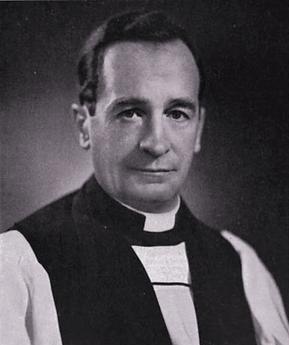Horace W. B. Donegan facts for kids
Quick facts for kids The Right Reverend Horace W. B. Donegan D.D., S.T.D., D.C.L., CBE |
|
|---|---|
| Bishop of New York | |
 |
|
| Church | Episcopal Church |
| Diocese | New York |
| Elected | 1949 |
| In Office | 1950–1972 |
| Predecessor | Charles Kendall Gilbert |
| Successor | Paul Moore Jr. |
| Orders | |
| Ordination | May 28, 1928 |
| Consecration | October 8, 1947 by Henry Knox Sherrill |
| Personal details | |
| Born | May 17, 1900 Matlock Bath, Derbyshire, England |
| Died | November 11, 1991 (aged 91) Sanibel, Florida, United States |
| Nationality | English |
| Denomination | Anglican |
| Parents | Horace George Donegan & Emma Pembroke Hand |
| Previous post | Suffragan Bishop of New York (1947-1950) Coadjutor Bishop of New York (1950) |
Horace William Baden Donegan (May 17, 1900 – November 11, 1991) was an important leader in the Episcopal Church in the United States. He served as the Bishop of New York for many years, from 1950 to 1972. He was known for his strong support of civil rights and helping those in need.
Contents
Early Life and Journey
Horace Donegan was born in Matlock Bath, England, in 1900. His family's last name was originally Donegani. His father was a butcher.
When Horace was ten, his family moved to the United States. They settled in Baltimore, Maryland. Their last name was changed to "Donegan."
Horace first wanted to be a stage actor. However, he later decided to follow a religious path. He never married, even though Episcopal clergy are allowed to marry.
Education and Learning
Donegan studied at St. Stephen's College in New York. He also attended Harvard Divinity School. He studied theology at Oxford University in England.
In 1927, he earned his divinity degree. This degree was from the Episcopal Divinity School in Cambridge, Massachusetts.
Becoming a Priest
Horace Donegan became a priest on May 28, 1928. For two years, he worked as a curate at All Saints' Church in Worcester, Massachusetts.
After that, he was the rector of Christ Church in Baltimore. In 1933, he became the rector of St. James' Episcopal Church in Manhattan.
Leading as a Bishop
In 1947, Donegan was chosen as the Suffragan Bishop of New York. This was the second-highest position in the diocese. He officially became a bishop that same year.
In 1949, he was chosen as the coadjutor bishop for the same diocese. This was a special honor, as he was chosen by everyone's agreement. He also helped create and lead the House of the Redeemer.
Bishop of New York
When Bishop Charles Kendall Gilbert retired in 1950, Donegan became the twelfth Bishop of New York. He was known for his liberal views. He was very active in social issues.
Bishop Donegan strongly supported civil rights. He defended the rights of African Americans, women, and the poor. He believed the church needed to change to help address problems like racism and poverty in New York.
He spoke out against McCarthyism. This was a time when many artists were unfairly treated for their past political beliefs. He also opposed apartheid in South Africa. Apartheid was a system of racial segregation.
Helping Others and New Ideas
In 1955, Bishop Donegan helped a family of German refugees. He sponsored an apartment for them and helped the husband find work.
In 1956, he allowed women to be elected as church leaders. These roles included wardens and delegates to church conventions. Later, in 1971, he helped ordain two women as deacons.
Donegan helped create the American Priory of the Order of St John. In 1957, Queen Elizabeth II honored him. She named him an honorary Commander of the Order of the British Empire (CBE).
That same year, he started a program to build new churches. These churches were for poor areas of Manhattan and the Bronx. He saw this as a very important opportunity for the church.
Supporting Leaders and Causes
Bishop Donegan encouraged Episcopalians to support John F. Kennedy in the 1960 presidential election. This was even though Kennedy was Roman Catholic.
After Kennedy's assassination in 1963, Donegan shared his deep sadness. He said Kennedy joined other "martyred leaders" like Lincoln.
In 1965, some church members stopped donating money. They were upset by Donegan's support for the civil rights movement. He said that the unfinished Cathedral would show that the diocese tried to do what was right.
He also spoke about the Vietnam War. He said he didn't understand why young men refused to serve. He believed everyone should serve their country in some way.
In 1967, Bishop Donegan made a big announcement. He decided to use donations meant for finishing St. John the Divine. Instead, the money would go towards housing projects in nearby Harlem. He believed the unfinished cathedral showed that society was still "rough-hewn, ragged, broken and incomplete."
Retirement and Later Life
Donegan retired in 1972. He had been the spiritual leader of the Diocese of New York for 22 years. He returned to St. James' Church. There, he worked as a parish pastor.
He often preached and helped with Communion services. He spent his summers in his home country, England. He enjoyed reading biographies, listening to Gilbert and Sullivan operettas, swimming, painting landscapes, and golf.
Horace Donegan passed away in Sanibel, Florida, at age 91. He died from throat cancer.

